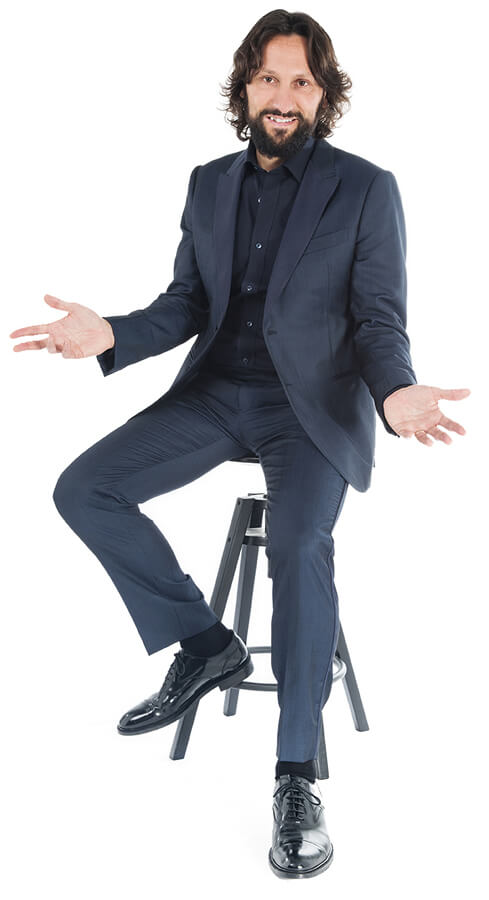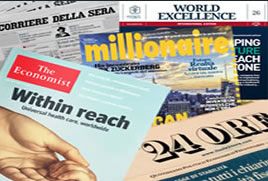
In how many different ways can your company produce today?
Certainly, there are many ways.
There is an endless variety of machines on the market, but sometimes, this wide choice, instead of benefiting the end consumers, ends up confusing them to the point that they are no longer able to choose.
Through the years, I have met all sorts of customers, such as those attracted by the last-minute discount.
Since 2008, I have seen companies discount their products by even up to 50%, just to get rid of stock that filled the warehouses of desperate importers on the edge of bankruptcy, warehouses so full of machinery that the company was forced to put them in their parking lot.
On the opposite side, I have met customers simply in love with extreme technology, the kind that says “whatever it costs, I want the most technically advanced machine, with latest-generation systems and equipped with all optional accessories (a mountain of technology).
But, this mountain is often likely to collapse on top of you, in the sense that you are crushed by the complications that it generates.
The first case represents companies I usually do not do business with. In fact, I cannot quench their thirst for discounts just to get a higher percentage and establish a new record.
The buyer is not aware that they are purchasing a CNC machine that is already obsolete or with characteristics that are no longer in step with modern times.
Incidentally, here is a bit of practical advice: always remember to check which type of CNC machine is being offered, the year of manufacture and, obviously the model.
Then, call the manufacturer yourself to see for how long they are able to guarantee the availability of spare parts*.
I gave this advice to customers in the past, and I can assure you that there were a few surprises!
This attitude of a discount-thirsty vampire does not concern the machines made by PORTA SOLUTIONS, since in order to satisfy these customers we would have to set up a different business model, based on the cheapest possible materials, and we would not be able to take care of assembly and the details of the machine as we do today.
The second type of customer, in search of the most advanced technology, promoted at all costs and perhaps developed for the first time just to have the “newest thing”, will also be dissatisfied by dealing with me, as they would receive several NO answers to requests implemented for the first time and not tested beforehand.
Generally speaking, too many complications go against my philosophy of building simple machines that can be easily used by anyone.
BUILDING SIMPLE MACHINES THAT CAN BE EASILY USED BY ANYONE
So, at this point you are probably asking yourself: who actually purchases your machine tools?
Or you might be thinking to yourself: you will never find the ideal customer by acting this way…
The answer is simple: I don’t sell machines, I sell COST PER PIECE!
As a first step, I don’t go knocking on doors of potential customers in a desperate attempt to persuade someone to purchase my products, hoping to hypnotise them or place them under a spell using magic words.
Lately, I am fortunate enough to receive calls from customers looking for solutions aimed at improving their competitiveness, customers willing to engage in an open discussion in order to find, together, the right balance between investment and final result.
I have noticed that often these customers are not looking for a 50% discount or an overly complicated “dream machine”; instead they are interested in achieving a very important, though often forgotten, objective: the COST PER PIECE.
I find myself quite at ease with this type of customers because, like me, they go straight to the point: the main focus is, in fact, the COST PER PIECE.
If you think about it for a moment, what good does it do to make philosophical speeches on the type of machine tool to be used, on which production theory to adopt, if you then fail to concentrate on the COST PER PIECE?
FOCUS ON THE COST PER PIECE, NOT ON THE TYPE OF MACHINE TOOL….
The machine is a consequence, only a simple consequence.
It might as well be a large cardboard box with a slot where you put in the raw piece and the finished piece comes out at a certain COST PER PIECE. What does it matter to you how this cardboard box is made on the inside?
This is why I told you that I don’t sell machines, but rather the COST PER PIECE. Actually, by taking this concept to the extreme, I am selling the COST PER PIECE, a service; the machine is just a means, just like the tooling equipment, the tools and so on.
All elements that are needed to achieve the truly important figure, the COST PER PIECE.
We need to be careful when talking about COST PER PIECE in absolute terms, since it does not mean processing the piece as fast as possible under the illusion that by doing so the piece costs less, as it was done in the past.
The issue needs to be evaluated taking all its aspects into account.
One example is the lot size. It is pointless to produce at the speed of light when it then takes days to re-tool a machine if you need to frequently carry out this operation.
Another example is not only the simple re-tooling of the machine, but also the introduction of the variable: “with unskilled personnel”.
It is easy to root for a race team if the driver is someone like Earnhardt or Schumacher.
Or again, understanding the energy consumption for each produced piece compared to other types of machines, the space taken up, the personnel needed to operate the machine, the cost of the tools and so on.
So, whenever the conversation with a potential customer starts with the phrase: “What sort of a discount do you apply on your machines?”.
It is interesting to notice that in some cases, actually this only happened once, but it was one time too many, the customer did not even know the cost of the machine and expected to be told the discount percentage straight off the bat.
IF YOU ARE THE TYPE OF PERSON WHO IS ONLY LOOKING FOR A DISCOUNT, LET ME BE HONEST WITH YOU: WE CANNOT WORK TOGETHER…
If, on the other hand, you are seriously interested in better understanding the COST PER PIECE concept, then keep on reading, as I will now explain step by step how this approach is structured.
I do this for you free of charge during the offer phase, but only to those people who are seriously interested in what I have to offer.
Everything is developed using an algorithm specifically created in order to calculate this famous COST PER PIECE based on variable data to be entered at the beginning, as explained below:
- WORK DAYS: this information must be provided by the end user, which is you in this case, since it has an impact on machine amortization.
- AMORTIZATION TIME FRAME: once again, you have to decide in how many years you want to pay off the machine; obviously, the shorter the amortisation period, the more you will have to work at a higher hourly cost; vice versa, the longer the amortisation period the lower your hourly cost, but in this case you will need more time pay it off.
- SYSTEM YIELD: this figure is provided by PORTA as a % amount, and it represents the availability of the machine to be used; the difference is used for preventive or unscheduled maintenance activities.
- OPERATORS NEEDED TO RUN THE SYSTEM: this figure represents the number of operators needed so that the system can operate properly.
The big difference is whether or not the machine is equipped with an automatic loading robot or if a dedicated operator is needed for the loading and unloading operations.
- HOURLY LABOUR COST: this represents the cost of your operator, which consists of the wages paid out along with all burden, overhead, and applicable taxes, basically, the company cost.
- ANNUAL MAINTENANCE: this figure is expressed as a % of the total value of the machine, and it is provided by PORTA based on recorded history pertaining to previous machines.
- PLANT REVALUATION COEFFICIENT: summed up in just one word, INFLATION.
- DEPRECIATION COEFFICIENT: this is the write-down incurred by the system with the passing of time.
- EQUIPMENT COST: in addition to the machine, we identify the equipment cost at which we can decide to apply a shorter amortisation compared to the machine.
- COST OF TOOLING: the aforementioned technique of using a different amortisation rate compared to the machine can be applied in this case too.
- INSTALLED POWER: this topic has become very popular in recent years. A MULTICENTER machine usually consumes 50% less power compared to 3 machining centers!
- POWER USE FACTOR: this is the actual power used by the system, and not the sum in kW of all motors that make up the system, a figure provided by PORTA.
- ELECTRICITY COST: the simple cost per kW that can be obtained from your company’s energy bill.
- SYSTEM COST: cost of the investment.
- HOURLY PRODUCTION: in other words, the cycle time for producing a piece.
Once all the information referred to above has been carefully entered, the algorithm calculates our output figure: the COST PER PIECE, which consists of the following items that, when summed up, give precisely the COST PER PIECE.
- SYSTEM DEPRECIATION PORTION: this serves to pay for the system.
- SYSTEM MAINTENANCE PORTION: this is used to pay the maintenance carried out on the machine over time.
- LABOUR PORTION: this is used to pay the operator.
- EQUIPMENT PORTION: this is also simple to understand…
- TOOLING PORTION: just as easy.
- ELECTRICITY PORTION: based on the declared kW, this is used to pay the energy bill.
As already mentioned, by summing up all these figures we get the total sum, which is none other than our COST PER PIECE.
After having analysed the cost per piece, we need to evaluate the lot sizes, since from this analysis we can start to determine which type of equipment and which level of output needs to be applied. There is no right or wrong solution in this case as well.
The right solution must be determined based on the changeover frequency and on the cost of the equipment itself, which also has an impact. Taking it one step further, everything needs to be seasoned with another variable: the operator that uses this machine and is assigned to its changeover.
Do we want to calculate our cost by taking into account a qualified operator with a certain hourly cost, or a less experienced one?
As you can see, the discussion is wide-ranging.
These are topics to which I am deeply attracted and which are fascinating to me, since it gives me great satisfaction when I am able to present tangible and practical solutions.
This is the reason why basing the discussion on “HOW MUCH DISCOUNT WILL I GET ON THE MACHINE” is really not my thing.
In fact, I tend to quickly lose interest in the deal, perhaps even coming off a bit conceited, but I really cannot do it, no matter how hard I try!
I am on a flight from Charlotte to New York as I write these lines.
This week, I visited existing and potential customers with whom I had the chance to discuss these issues.
This is the reason why today, while thinking about the various meetings, I threw myself into this topic. This constant exchange of views with different companies, during these first 20 years of working while visiting all kinds of businesses, has allowed me to grow, especially by listening to their daily problems and then presenting suitable solutions. When I visit a company, I can assess the probability of a sale during the very first meeting.
This is not because I am a magician, or even particularly smart, but because of the issues the customer wishes to discuss.
THIS WORK METHOD HAS ALWAYS BEEN VERY GRATIFYING TO ME, AND I AM ALWAYS LOOKING FOR PEOPLE WHO SHARE THE SAME APPROACH.
The proof that this system works and that it is so powerful is that after delivering the machine to those customers who chose this work method, they call me again to study other COSTS PER PIECE using the same method, in order to acquire orders that they would have rejected if assessed in a different way or, even better, orders that they would have lost!
Now, here are the usual questions to help you to really understand the right path for your company.
Try to answer the following three questions; take 10 minutes of your time and, as always, try to jot down your answers directly from here: it is very important to write them down instead of just thinking them, since writing requires concentration, that concentration that we often do not have for lack of time, and that however makes us make the WRONG decisions or, even worse, not make any decision at all.
WHAT WOULD CHANGE AT YOUR COMPANY IF YOU FOCUSED ON THE REAL DATA OF THE COST PER PIECE FROM A 360-DEGREE VIEW?
… AND WHAT HAPPENS IF YOU KEEP ON INSTALLING MACHINERY WITHOUT APPLYING THE COST PER PIECE METHOD?
WHAT WOULD BE THE RISKS FOR YOUR COMPANY IF YOU DID NOTHING AND SIMPLY POSTPONED YOUR DECISIONS?
*Do ask the manufacture of the CNC and not the machine manufacturer.
For more information on the Flexible Production…
please CLICK HERE!
Maurizio Porta
Expert in Flexible Production

 Ita
Ita Deu
Deu
